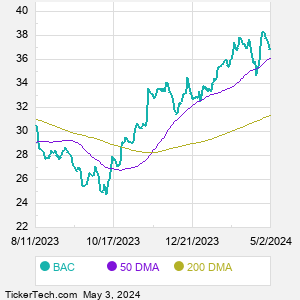Bank of America is a bank holding company. Through its subsidiaries, Co. provides banking, investing, asset management and other financial and risk management products and services. Co.'s segments are: Consumer Banking, which provides credit, banking and investment products and services; Global Wealth and Investment Management, which provides investment management, brokerage, banking and retirement products; Global Banking, which includes lending-related products and services, integrated working capital management and treasury solutions; Global Markets, which provides sales and trading services and research services; and All Other, which includes asset and liability management activities.
When researching a stock like Bank of America, many investors are the most familiar with Fundamental Analysis — looking at a company's balance sheet, earnings, revenues, and what's happening in that company's underlying business. Investors who use Fundamental Analysis to identify good stocks to buy or sell can also benefit from BAC Technical Analysis to help find a good entry or exit point. Technical Analysis is blind to the fundamentals and looks only at the trading data for BAC stock — the real life supply and demand for the stock over time — and examines that data in different ways. One of those ways is to calculate a Simpe Moving Average ("SMA") by looking back a certain number of days. One of the most popular "longer look-backs" is the BAC 200 day moving average ("BAC 200 DMA"), while one of the most popular "shorter look-backs" is the BAC 50 day moving average ("BAC 50 DMA"). A chart showing both of these popular moving averages is shown on this page for Bank of America. Comparing two moving averages against each other can be a useful visualization tool: by calculating the difference between the BAC 200 DMA and the BAC 50 DMA, we get a moving average convergence divergence indicator ("BAC MACD"). The BAC MACD chart, in conjunction with the chart of the moving averages, basically helps in visualizing how the moving averages are showing convergence (moving closer together), or divergence (moving farther apart). |



